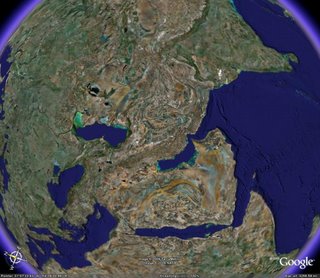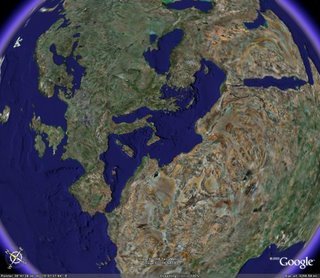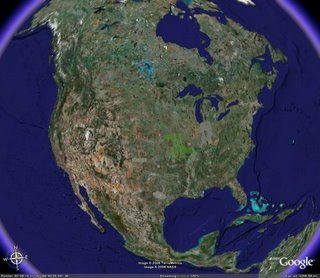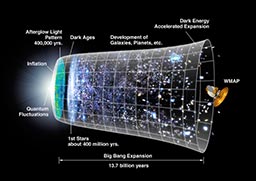There's no specific reason i am posting this now, except that the life found around thermal vents has always fascinated me, from the first time I started hearing about it. It ties into my interest in SETI and extra-terrestrial life because in many very real ways, the environment around thermal vents isn't terrestrial in any way. From
dictionary.com, terrstrial is ...
ter·res·tri·al  ( P ) Pronunciation Key
( P ) Pronunciation Key (t

-r

s

tr

-

l)
adj. - Of or relating to the earth or its inhabitants.
- Having a worldly, mundane character or quality.
- Of, relating to, or composed of land.
- Biology. Living or growing on land; not aquatic: a terrestrial plant or animal.
I suppose I have to give thermal vent life a point for definition one ... the vents DO exist on earth, but the other 3 don't really even come close. 3 & 4 have OBVIOUS problems when talking about life 2 miles beneath the ocean, and even #2 is hard to work with. At best, its a stretch to say that thermal vent life is mundane, or similar in character to other wordly life.
Anyway, I was fascinated by a few things in the article. Previous reading had left me with the impression that the environment of thermal vents was intensely hot, and while that seems to be true, I hadn't realized how quickly the water around the vents cooled down. As this article points out, that makes it mostly the odd chemical mix, not the intense heat, that most of the life thrives on. One of the other interesting points was the notion of vents popping up for a few years or decades (or longer?) and then dying out. Yet at each new site, it seems life springs up almost immediately. The higher life, such as lobsters and octopus's that seem to have adapted to the toxic environment raise interesting for me about whether colonies of life around the vents springs up on its own, or moves.
Its clear that vents speak to life off the planet earth, however. Again, as the article points out, the vents spew a chemical brew that is throroughly toxic to what we normally think of as life. The giant tube worms are a fascinating visual spectacle, swaying in the 'breeze' as they do, but I think the real fascination is in the wealth of higher creatures who have developed and thrived in this environment, and the structure of how they survive will likel speak to the structure of life off planet earth. The surface of Venus, as one example, is a place that closely resembles an undersea thermal vent. Intense pressures, weird chemical mixes, high temperatures, the entire surface is essemtially like the inside of a high pressure thermal vent. Unlike our ocean, it doesn't cool down anywhere, but we know that life exists in both the high and low temp areas of the vent. With so much area, and so much varied terrain and food sources, one wonders what sort of ecosystem might develop.
Or take Titan. The recent data from Huygens and Cassini show a cold place, but a place rich in petrocarbons. Even Mars looks to have a deeply buried aquifer, and there are several other fascinating candidates in our solar system alone now for life. Recently, my New Continuum group also posted a fascinating article on the 8 places where life might exist that touches on this ... I will paste it below the Popular Science article.
http://seawifs.gsfc.nasa.gov/OCEAN_PLANET/HTML/ps_vents.html

Creatures of the Thermal Vents
by Dawn Stover
The three-person submersible Alvin sank through the cold, dark waters of the Pacific Ocean for more than an hour, finally touching down on the sea floor more than 8,000 feet below the surface. It was December 1993, and the scientists inside the sub had come to this stretch of the East Pacific Rise, an underwater mountain range about 500 miles southwest of Acapulco, Mexico, to inspect a recently formed hydrothermal vent - a fissure in the ocean bottom that leaks scalding, acidic water.
 Peering out through the sub's tiny windows, the visitors were astonished to see thickets of giant tube worms, some four feet tall. The tail ends of the worms were firmly planted on the ocean floor, while red plumes on the other ends swayed like a field of poppies. Alvin had brought researchers to the same spot less than two years earlier, when they had seen none of these strange creatures. Measurements at the site have since shown that individual tube worms can increase in length at a rate of more than 33 inches per year, making them the fastest-growing marine invertebrates. That means tube worms can colonize a vent more rapidly than scientists once thought.
Peering out through the sub's tiny windows, the visitors were astonished to see thickets of giant tube worms, some four feet tall. The tail ends of the worms were firmly planted on the ocean floor, while red plumes on the other ends swayed like a field of poppies. Alvin had brought researchers to the same spot less than two years earlier, when they had seen none of these strange creatures. Measurements at the site have since shown that individual tube worms can increase in length at a rate of more than 33 inches per year, making them the fastest-growing marine invertebrates. That means tube worms can colonize a vent more rapidly than scientists once thought.
photo © Al Giddings/Images Unlimited, Inc.
The giant tube worm is one of the most conspicuous members of a diverse community that forms around hydrothermal vents. Scientists once thought that no living thing could survive the harsh combination of toxic chemicals, high temperatures, high pressures, and total darkness at these vents. But in 1977, researchers diving in Alvin discovered tube worms and other bizarre organisms thriving at a vent off the Galapagos Islands. Similar communities have since been found at several hundred hot spots around the world. These creatures are like nothing else on Earth.
Vents form where the planet's crustal plates are slowly spreading apart and magma is welling up from below to form mountain ranges known as mid-ocean ridges. As cracks form at these spreading centers, seawater seeps a mile or two down into the hot rock. Enriched with minerals leached from the rock, the water heats and rises to the ocean floor to form a vent.
Vents are usually clustered in fields, underwater versions of Yellowstone's geyser basins. Individual vent openings typically range from less than a half inch to more than six feet in diameter. Such fields are normally found at a depth of more than a mile. Most have been discovered along the crest of the Mid-Oceanic Ridge, a 46,000- mile-long chain of mountains that wraps around Earth like the seams on a baseball. A few vents have also been found at seamounts, underwater volcanoes that are not located at the intersection of crustal plates.
The largest vent field, called TAG (short for Trans-Atlantic Geotraverse), is about the size and shape of a football stadium. Other fields have more whimsical names like Clam Acres, Mussel Bed, Rose Garden, Garden of Eden, Broken Spur, and Lucky Strike. Snow Blower is named for the white, flaky bacteria discharged from its vents. Genesis is a vent that sputtered out but came back to life a few years later.
Hydrothermal vents are underwater oases, providing habitat for many creatures that are not found anywhere else in the ocean. More than 300 new species have been identified since the first vent was discovered in 1977.
Besides the giant tube worms, which have so far been found only in the Pacific, there are pencil-size Jericho worms with accordion-like tubes; orange worms covered with tiny bristles; small benthic worms that wriggle through the mud; and finger-length, dark red palm worms that stand upright, topped with wiglike fronds. A special class of small worms, called Alvinellids (named after the sub), live on the walls of mineral deposits that form around vents.
Mussels, shrimp, clams, and crabs are abundant at many vents, but these are not the same species that you find in seafood dishes. The cocktail-size shrimp that dominate vents in the mid-Atlantic, for example, have no eyes. However, at least one species has an extremely sensitive receptor on its head that may be used to detect heat or even dim light coming from vents. Scientists still aren't sure how shrimp and other vent creatures cope with chemical-laden seawater that would kill ordinary shellfish.
Biologists have observed a variety of smaller crustaceans around vents, including miniature lobsters called galatheids, and amphipods resembling sand fleas. They have also seen snail-like limpets the size of BBs, sea anemones, snakelike fish with bulging eyes, and even octopuses.
While octopuses are at the upper end of the vent's food chain, bacteria are at the bottom. They are the first organisms to colonize newly formed vents, arriving in a snowlike flurry and then settling to form white mats or tendrils attached to the ocean floor. Bacteria have been found living beneath the ocean's floor, and it seems likely that they emerge from below when the conditions are right. Vent bacteria can withstand higher temperatures than any other organism. That makes them attractive to researchers who are developing heat-stable enzymes for genetic engineering, and culturing bacteria designed to break down toxic waste.
Water pouring out of vents can reach temperatures up to about 400 C; the high pressure keeps the water from boiling. However, the intense heat is limited to a small area. Within less than an inch of the vent opening, the water temperature drops to 2 C, the ambient temperature of deep seawater. Most of the creatures that congregate around vents live at temperatures just above freezing. Thus chemicals are the key to vent life, not heat.
The most prevalent chemical dissolved in vent water is hydrogen sulfide, which smells like rotten eggs. This chemical is produced when seawater reacts with sulfate in the rocks below the ocean floor. Vent bacteria use hydrogen sulfide as their energy source instead of sunlight. The bacteria in turn sustain larger organisms in the vent community.
The clams, mussels, tube worms, and other creatures at the vent have a symbiotic relationship with bacteria. The giant tube worms, for example, have no digestive system - no mouth or gut. "The worm depends virtually solely on the bacteria for its nutrition," says microbial ecologist Colleen M. Cavanaugh of Harvard University. "Both partners benefit."
The brown, spongy tissue filling the inside of a tube worm is packed with bacteria - about 285 billion bacteria per ounce of tissue. "It's essentially a bacterial culture," says Cavanaugh.
The plumes at the top of the worm's body are red because they are filled with blood, which contains hemoglobin that binds hydrogen sulfide and transports it to the bacteria housed inside the worm. In return, the bacteria oxidize the hydrogen sulfide and convert carbon dioxide into carbon compounds that nourish the worm.
Tube worms reproduce by spawning: They release sperm and eggs, which combine in the water to create a new worm. Biologists don't know how the infant worm acquires its own bacteria. Perhaps the egg comes with a starter set.
Scientists also don't know how tube worms and other organisms locate new vents for colonization. "The vents are small, and they're separated, like islands," says Cindy Lee Van Dover, a biologist and Alvin pilot who studies vent life. Most vent organisms have a free- swimming larval stage. But scientists aren't sure whether the larvae float aimlessly or purposely follow clues - such as chemical traces in the water - to find new homes.
Studying the life cycle of vent organisms is difficult. Researchers have visited only a fraction of the ocean's hot spots. They have been able to observe vent life only by shining bright lights on creatures accustomed to inky darkness, and many specimens die quickly when removed from their unique environment. Underwater cameras are helping scientists make less intrusive observations, but diving expeditions are still the most useful way to gather information. The 1993 Alvin expedition to the East Pacific Rise was one in a series of dives to the area. The site was first visited in 1989, and scientists observed vent organisms thriving there. But when Alvin returned in April 1991, its flabbergasted occupants witnessed the birth of a hydrothermal vent. A recent volcanic eruption had spread glassy lava across the ocean floor, and the researchers measured temperatures up to 403 C - the hottest ever recorded at a hydrothermal vent. The scientists dubbed the site Tube Worm Barbecue, because the worms they brought back to their ship had charred flesh.
"The most spectacular sight down there was this massive blinding snowstorm of bacteria," says Rich Lutz, a marine ecologist at Rutgers University, who led the expedition. On the ocean floor, the bacteria formed mats several inches thick, but the scientists saw no other living things.
Since the eruption, scientists have been able to watch several stages of colonization at the site. When they returned in March 1992, only a few bacterial mats remained. In their place were colonies of Jericho worms and a variety of small crustaceans. The scientists named the area Phoenix, because new life had arisen from the ashes of the eruption.
The scientists first observed the giant tube worms at Phoenix in December 1993. They also noticed a number of mineral deposits, some towering to heights of more than 30 feet. These structures form where hot vent water meets cold seawater, causing metal sulfides to precipitate out. The precipitating sulfides, which look like smoke, amass to form chimneys called black smokers. Like the vent fields, some smokers have names. Smoke and Mirrors, for example, has shelflike overhangs that trap hot water rising from below, creating upside-down shimmering pools. The largest known black smoker is Godzilla, a 160-foot-tall structure off the coast of Oregon.
During a December 1993 dive to the Phoenix vent field, Alvin accidentally toppled a 33-foot-tall smoker. When the sub returned for a brief visit three months later, the chimney had already grown back 20 feet. Scientists were surprised by the speedy recovery, which seems to parallel the rapid growth of tube worms and other organisms at the vents. The visits to the Phoenix site "give us a sense of how quickly these vents are colonized," says Van Dover.
Another expedition is planned for November. By then, the community of organisms now prospering at the vents may already be a ghost town. When the flow of hot, sulfide-rich water slows to a trickle, death also comes quickly.
 Ocean Planet Exhibition Floorplan
Ocean Planet Exhibition Floorplan

 gene carl feldman (gene@seawifs.gsfc.nasa.gov) (301) 286-9428
gene carl feldman (gene@seawifs.gsfc.nasa.gov) (301) 286-9428
Judith Gradwohl, Smithsonian Institution (Curator/Ocean Planet) EdB (myxtplkn@yahoo.com) thought you might be interested in this news article
from SPACE.com.
8 Worlds Where Life Might Exist
http://www.space.com/searchforlife/060323_seti_biomes.html
--
Its your karma ... use it wisely
http://elronsviewfromtheedge.blogspot.com/-----BEGIN GEEK CODE BLOCK-----
Version: 3.1
GIT$/P/L d- s: a39 C+++(++++) UL++++S++++$A++I+++ P+ E--- W++ N++ w---
V+++ PS+++ L++ t+++ 5++ X++ tv@ b+ DI+++ G e h+ r+ y**
------END GEEK CODE BLOCK------
Decode GeekCode at
http://www.ebb.org/ungeek/Make your own GeekCode at
http://www.geekcode.com/geek.html--elron


 An image like the one of Cameron on the left here isn't too far off a lot of the ancient fertility statues found. There are MANY people who find such an image obscene, or question the value of it, and others who might see art, or pleasure, or excitement in it.
An image like the one of Cameron on the left here isn't too far off a lot of the ancient fertility statues found. There are MANY people who find such an image obscene, or question the value of it, and others who might see art, or pleasure, or excitement in it.










